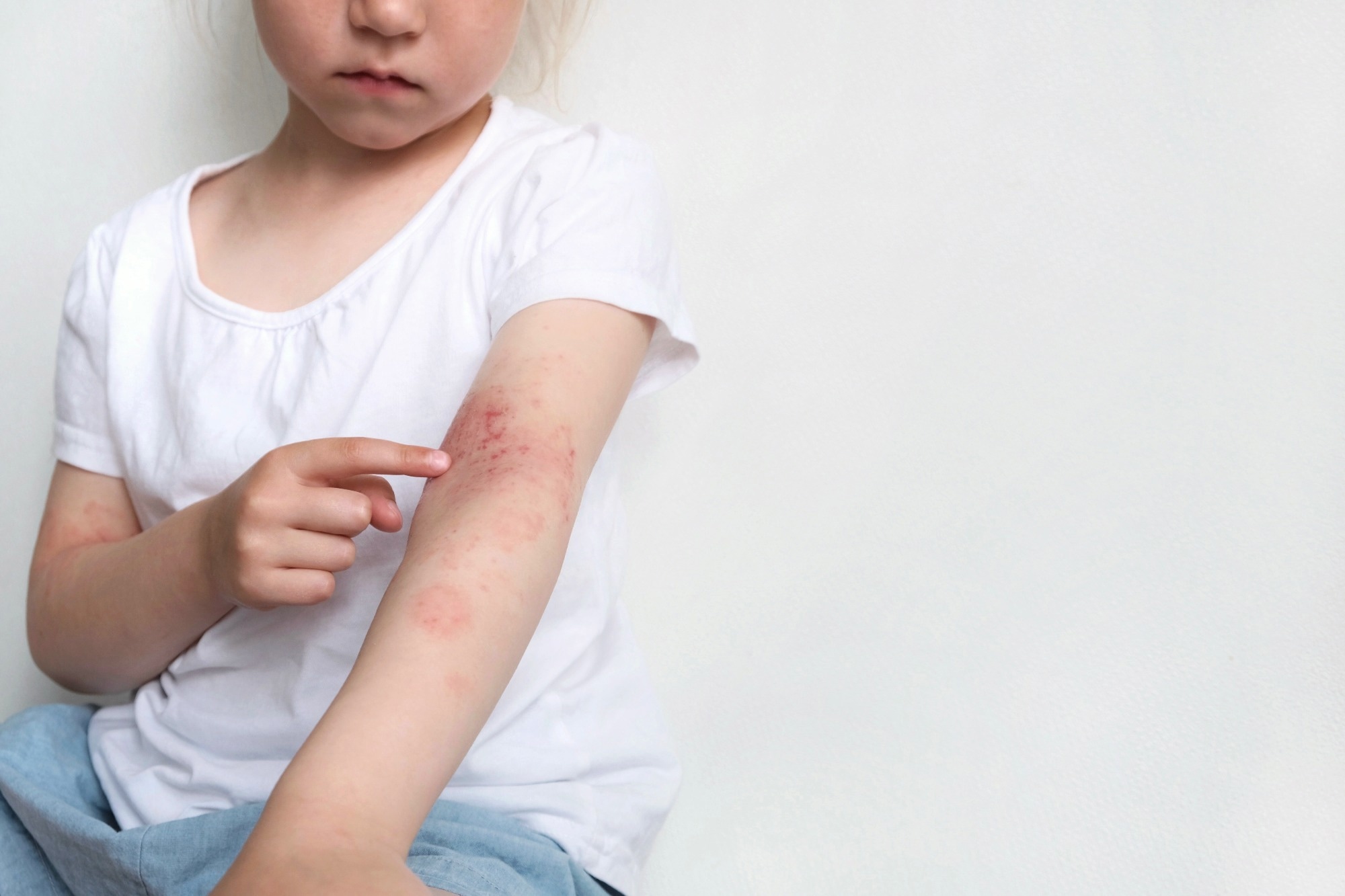In a recent review published in Frontiers in Medicine, researchers discuss current therapeutic interventions for atopic dermatitis in children and adolescents.
 Study: Anti-inflammatory and biologic drugs for atopic dermatitis: a therapeutic approach in children and adolescents. Image Credit: marishkaSM / Shutterstock.com
Study: Anti-inflammatory and biologic drugs for atopic dermatitis: a therapeutic approach in children and adolescents. Image Credit: marishkaSM / Shutterstock.com
Background
Atopic dermatitis is a chronic inflammatory skin disease that frequently affects children and adolescents. The disease is associated with an impaired immune system and a prevalence in T helper 2 (Th2)-mediated immune responses.
Treatments for atopic dermatitis primarily depend on its severity, with medication-loaded emollients commonly prescribed. In the current review, scientists provide a detailed overview of recent studies published within last five years on novel medications for pediatric atopic dermatitis.
Therapeutic management of atopic dermatitis
The first-line treatment for atopic dermatitis in children and adolescents is topical corticosteroids. The early use of high-potency corticosteroids at the onset of acute disease helps control inflammation, regenerate the skin barrier, and reduce long-term use of the medication. In skin areas with higher absorption, such as the eyelids, genitals, and face, low-to-moderate potency corticosteroids are generally applied.
The development of resistance to topical corticosteroids, which is a condition otherwise known as corticophobia, can occur in 60-73% of children with atopic dermatitis, which is the main reason for non-adherence. Application of the medicine using the Fingertip Unit can reduce the risk of corticophobia.
Topical calcineurin inhibitors, including tacrolimus 0.03% ointment and pimecrolimus 1% cream, are second-line treatments approved for treating patients two years and older. For patients aged 16 years and above, tacrolimus 1% is approved.
These treatments provide long-term relieve from itching and acute lesions; however, possible side-effects include allergic contact dermatitis, rosacea-like granulomatous reactions, melanosis of the lips, and viral infections.
Oral corticosteroids like methylprednisolone are used for flares or severe disease. Long-term use of oral corticosteroids can cause suppression of the hypothalamic-pituitary-adrenal axis, hypertension, weight gain, osteoporosis, and growth impairment in children.
Oral antihistamines are used to reduce itching that affects sleep. However, both first- and second-generation antihistamines have low efficacy in treating atopic dermatitis.
The treatment is associated with several adverse side effects in children, including sedation and cholinergic symptoms. Topical antihistamines are not recommended for children due to the risk of systemic toxicity.
Immunosuppressive agents
Cyclosporin A, a calcineurin inhibitor, is the first-line of defense for providing rapid relief of symptoms when other treatments are not available or contraindicated. Currently, 5mg/kg/day of cyclosporin A, either continuously for 12 months or an intermittent 12-week regimen, is advised for children between two and 16 years of age with severe atopic dermatitis.
This dosage may induce infection, nephrotoxicity, hypertension, tremor, hypertrichosis, headache, gingival hyperplasia, skin cancer, and lymphoma. For non-severe disease, a dose of 2.5-5 mg/kg/day split into two doses is advised.
Methotrexate, azathioprine, and mycophenolate mofetil are second-line medications used to treat severe atopic dermatitis. Methotrexate is only moderately effective in children and adults and may induce hepatic toxicity, pancytopenia, teratogenicity, and idiopathic pulmonary fibrosis in rare instances. Thus, blood counts and renal and liver profiles should be routinely monitored.
Azathioprine is another low-efficacy treatment that is associated with various side-effects including hepatotoxicity, myelotoxicity, and carcinogenicity. Serum thiopurine S-methyltransferase activity permits safer use of this medicine in children.
Mycophenolate mofetil is more effective and safer than azathioprine in children with severe atopic dermatitis. The medicine improves symptoms within six to seven weeks.
Biologics
Atopic dermatitis is associated with upregulated cytokine production by Th2 lymphocytes and T2 innate lymphoid cells. Based on this etiology, monoclonal antibodies targeting T2 cytokines have been developed to treat moderate-to-severe disease not controlled by topical corticosteroids.
To date, dupilumab, tralokinumab, and lebrikizumab have received approval for treating adults and adolescents, with dupilumab currently approved for treating children six months and older. In children between six months and 17 years of age, dupilumab effectively reduces itching, eczema, and sleep disturbances. The most common adverse effects associated with antibody treatments include conjunctivitis and upper respiratory tract infection.
Several novel anti-T2 cytokine biologics targeting interleukins (ILs) other than IL-4 and IL-13 are currently being investigated. Of these biologics, nemolizumab has been tested in adolescents. In patients aged 13 years and older, 60 mg of nemolizumab for four weeks has been found to reduce itching and eczema and improve dermatology-related quality of life.
Small molecules
Small molecules including phosphodiesterase-4 (PDE-4) and Janus Kinase (JAK) inhibitors, have received approval for treating children with atopic dermatitis. Among several PDE-4 inhibitors, crisaborole is used for patients three months and older, whereas difamilast is used for patients two years and older and roflumilast is recommended for patients aged 12 years and older. These inhibitors are used for mild-to-moderate disease and have shown promising clinical outcomes and good tolerability.
Among topical JAK inhibitors, ruxolitinib has shown promising outcomes in children, including reduction of itching and skin thickening; however, more safety trials are needed. Three oral JAK inhibitors including upadacitinib, abrocitinib, and baricitinib have received clinical approval for adolescents 12 years and older. Although these treatments have shown promising outcomes in clinical trials, they are associated with certain side effects, including cardiovascular complications, serious infections, and cancer.